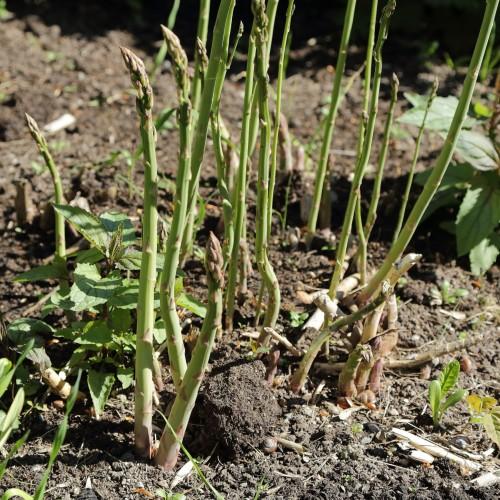
asparagus
Asparagus officinalis 'Mary Washington'
Cycle:
Herbaceous Perennial
Watering:
Average
Hardiness Zone:
3 - 10
Flowers:
Flowers
Sun:
Full sun
Growth Rate:
Low
Maintenance:
Low
Salt Tolerant:
Yes
watering
Asparagus (Asparagus officinalis 'Mary Washington') should be watered once per week in the summer and every 2 weeks in the fall and winter. When watering, be sure to keep the soil moist but not saturated. If appropriate drainage systems are in place, water until it seeps out the bottom of the planter or directly onto the area where the plant is planted. During the summer, additional water may be necessary during hot spells or periods of prolonged dryness. If the soil feels dry, it's time for a good deep watering. Water in the morning or early afternoon to give the plants a chance to drink up and dry off before nightfall, helping decrease the risk of fungus and disease.
sunlight
Asparagus 'Mary Washington' requires 6 to 8 hours of direct sunlight each day but can tolerate some shade during part of the day. Plant it in a sunny spot that gets morning sun -- this is the best type of light for the healthiest growth. Avoid planting in an area that gets only afternoon sun, as this could cause the spears to become spindly and weak, and the plant may not thrive. The plant should be kept in full sun for the majority of the day.
pruning
Pruning should be done on an as-needed basis for Asparagus officinalis 'Mary Washington'. In most cases, it can be pruned in late winter or early spring when the plant is dormant and before new growth begins in the spring. The main objective when pruning Asparagus officinalis 'Mary Washington' is to remove dead and damaged foliage, as well as any overcrowded stems or offsets. Care should be taken to only remove the amount of foliage necessary. Pruning should not exceed 1-third of the total foliage. Remember to clean and sanitize pruning shears after cutting back foliage to avoid spreading disease.
Propagation
Season
Hardiness Map
FAQ
Is asparagus classified lilies or onions?
No, asparagus is not classified as either lilies or onions. Asparagus is a vegetable that is a member of the lily family, but it is not a lily itself nor is it an onion. Asparagus is a flowering plant and its edible part is the young shoots. It is high in dietary fiber and is a good source of vitamin A, vitamin C, vitamin E, vitamin K, and other vitamins and minerals.
Do asparagus plants not to be overwatered?
Yes, asparagus plants should not be overwatered. When planted outdoors, they should only receive enough water to keep the soil moist, but not soggy. If planted indoors, they should be watered when the soil is dry to the touch and the water should not be left to pool in the container or saucer. Overwatering asparagus plants can cause root rot and fungal diseases that can damage the plants.
Can I cultivate asparagus plant in a xeriscaping garden?
Yes, you can cultivate asparagus plant in a xeriscaping garden. Asparagus is a hardy, drought-tolerant plant that can survive well in low-water gardens. To successfully grow asparagus in a xeriscaping garden, the soil should be nutritiously rich with a slightly acidic pH. Choose a spot that gets full sun and provide your asparagus bed with a generous amount of mulch to retain moisture. Asparagus requires a deep, moderately moist soil—deep enough for the roots to grow. Provide your bed with regular watering, but do not over-water. Asparagus produces edible spears in its second season so if you plan to grow asparagus in your xeriscaping garden, be prepared to be patient.
Can asparagus be growing as a cover crop?
Yes, asparagus can be grown as a cover crop. As a cover crop, asparagus is non-invasive and nitrogen-fixing. It can be planted in cool climates starting in late winter and provides a living mulch with dense foliage that can be harvested throughout the season. It also helps protect the soil and provide erosion control, and it can be mowed or tilled in at the end of the season to return nutrients to the soil. Asparagus can even be intercropped with other vegetables, helping to increase yields and prevent disease.
Should I remove any wild asparagus plants from my garden?
Removing wild asparagus plants from your garden is entirely up to your personal preference. If you want more control over how many plants you have and what plants you have, then you may want to remove any wild asparagus plants. Wild asparagus plants can spread quickly and become difficult to control and manage. If you are okay with that then you may want to leave them in your garden. However, make sure you don't inadvertently dig up the wild asparagus plants and harm them. If you do decide to remove them make sure to do it responsibly so not to obsessively disturb the surrounding environment.
Are there any health benefits of asparagus roots?
Yes, there are numerous health benefits to eating asparagus roots. It is an excellent source of vitamins A, C, K, and B6, as well as minerals like copper, selenium, and iron. It also contains many antioxidants and is a good source of dietary fiber. Asparagus root also contains essential amino acids like lysine, leucine, and tryptophan, which are important for cellular health and energy production. Additionally, Asparagus root may provide potential anti-inflammatory and anti-cancer benefits.
